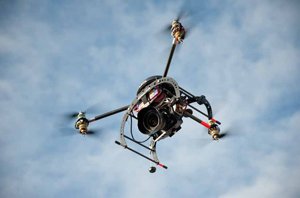articles/Equipment/remote-page1
Remote Control Aerial Platforms - part 1 of 1 2 3 4 5
by Mike McNamee Published 01/12/2012

Editing Imagemaker takes you to all sorts of places and into all sorts of new worlds. Aerial photography from unmanned, radio-controlled helicopters is just such an activity.
This part of the story starts at photokina when a number of RC helicopters were spotted on the DJI stand. The aircraft on show were multi-rotor (4-, 6- and 8-rotor) lightweight carbon fibre jobbies with a heavy-lift capability - enough indeed to haul a Canon 5D into the sky. An inconclusive discussion in broken English with the pretty little Chinese girl left us unwise as to the UK distributor but some Google searching on our return turned up Quadcopters. In one of those quirky coincidences that happen from time to time, Quadcopters are situated just along the road from Paul Gallagher, and so a couple of phone calls later we had arranged to go and see them.
Introduction
The development of digital cameras and accessories has been incremental since they were introduced. For the social photographer the main gains have been in low light capability, better performance and better lenses. Parallel to this rather staid but lucrative gain, the technology has exploded. The ability of the DSLR to shoot HD video has been a gamechanger and opened opportunities to include moving imagery in all sorts of ways.

A heavy-lift quadcopter looks down on the team from a stationary position.
Outside of photography other developments were also taking place. Very high strength but lightweight materials have come onto the market, initially from the space programmes but these have filtered down through military gear, aircraft, racing cars, and the like, until carbon fibre found its way into model aeroplanes. At the same time other technologies were developing namely:
1. Light batteries using lithium (a light and energetic element) and polymers (light and ion-conducting).
2. Better magnets to enable the creation of powerful but light electric motors.
3. Global positioning systems, so common that we find them as 'standard' in both mobile phones and some cameras.
Now your editor (and some members) will be old enough to remember things like the Keil Kraft Senator, powered essentially by a big rubber band. Then there was the very first electric, free flight model aeroplane (in the 1960s, made we think by Graupner with a name like 'elekton' but we are not quite sure). At this time radio-controlled models used valves and a crazy control system called Galloping Ghost - not the P-51 Mustang air racer but a way of controlling the direction of flight by flapping the rudder more in one direction than another. Power to drive the rudder flapping was supplied by a wound-up piece of elastic.
You are currently on page 1
- Remote Control Aerial Platforms page 1
- Remote Control Aerial Platforms page 2
- Remote Control Aerial Platforms page 3
- Remote Control Aerial Platforms page 4
- Remote Control Aerial Platforms page 5
1st Published 01/12/2012
last update 21/07/2022 08:46:25
More Equipment Articles
There are 32 days to get ready for The Society of Photographers Convention and Trade Show at The Novotel London West, Hammersmith ...
which starts on Wednesday 14th January 2026










